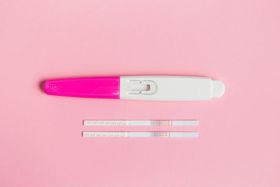What is Autoimmune Disease? And how to chart your cycle through it
Updated June 11, 2025

Each person has an immune system, which is meant to fiercely attack pathogens, bacteria, or any threat to well-being. It acts up when you're sick, get an immunization, or even just get a scrape on your knee. If it sees something in your body that doesn't belong there, it fights to keep the body healthy. But for some people, the immune system is actually a lot more than it's supposed to be - because they have what is called an "autoimmune disease."
What is an autoimmune disease?
An autoimmune disease occurs when the immune system begins to attack the body rather than an invader. The causes of autoimmune disease are not well-understood, and while there are some treatments available for many autoimmune diseases, there are currently no known cures for autoimmune diseases.
A few common autoimmune diseases you may have heard of include:
- Celiac
- Type 1 Diabetes
- Hashimoto's and Grave's (both affect the thyroid, in opposite ways)
- Rheumatoid Arthritis
- Crohn's
- Lupus
- Addison's
According to this study, at least 85% of people with multiple autoimmune diseases are women. While scientists are still working to determine exactly why that is the case, some are hypothesizing autoimmune disease is connected to the monthly inflammation of ovulation, and fluctuating estrogen and progesterone levels.
What is a "flare" or "flare up" and how are they triggered?
Autoimmune disease creates "flare ups" of the immune system. These flare ups usually start suddenly, and can be short-lived or chronic. Between autoimmune diseases and even individuals, there tend to be a wide variety of symptoms.
But some common ones include:
- Inflammation
- Muscle pain
- Brain fog
- Joint pain
- Fever
- Weight changes
- Fatigue
They may seem completely random - or provoked by infection, a specific food, poor sleep, or any number of other triggers. Notably, autoimmune flare ups can be triggered by hormonal transitions (like puberty, pregnancy, breastfeeding, and menopause). Flare ups can also be triggered by the relatively small hormonal fluctuations of an average ovulation cycle.
Benefits of Charting
If you’re charting your basal body temperature each day, you may notice if there is an estrogen-related flare up. You may notice that your symptoms are cyclical. This can help you plan ahead to support yourself. For example, if you know that your symptoms will be at their worst leading up to ovulation or just before menstruation, you can consider that while planning your work or social schedule, doing meal prep, or scheduling treatments to align with those times.
If your flare ups seem random, you might try tracking some lifestyle details on your chart to notice trends in flare ups. In addition to fertility signs, some people track diet, exercise, supplements, medication, sleep quality, hydration, stress, mood, and libido. Any of these could provide clues as to when you might expect a flare up.
Challenges of Charting
Perhaps the biggest challenge for those charting with an autoimmune disease is immune-related high temps. Basal body temperature often rises higher during or just before a flare up. The increased inflammation causes a heat reaction. This could look like a several-day fever on your chart. This could actually be a neat warning sign for those who are monitoring their daily temperatures. However, those using a fertility awareness based method as part of their contraceptive plan should chart with extra caution.
Tempdrop is great at filtering out less accurate temperatures (for example, fluctuations due to poor sleep or external factors), but an immune-related temperature fluctuation would likely (and thankfully) not be filtered out by the algorithm. This could mean that a perfectly-timed flare up could create a temperature pattern that looks like ovulation (even if it’s not), so using at least one other sign to confirm ovulation is key. Lastly, we should note that some people rarely or never see temperature fluctuations due to flare ups.
Autoimmune diseases that affect the thyroid often also affect basal body temperatures. People with Hashimoto’s may have lower average basal body temperature, while people with Grave’s may have higher average basal body temperature. Most people are still able to rely on their temperatures to confirm ovulation, but their range may be significantly lower or higher than someone with a healthy thyroid.
If you are trying a new treatment, your temperatures may fluctuate. Charting through new treatments can be highly beneficial, as changes may be apparent early in your chart. You may get some insight about the effectiveness of your treatment well before an improvement would show up in blood work. However, it is very important to record those treatments on your chart (particularly for those who are avoiding pregnancy).
Other Possible Connections
- Many people with rheumatoid arthritis reported decreased joint pain just after ovulation.
- People with connective tissue disorders (rheumatoid arthritis, multiple sclerosis, and other mast cell disorders) may noticed increased symptoms during menstruation when mast cells become highly activated.
- A reported 70% of women with multiple sclerosis reported worse symptoms in their late luteal phase.
- Low levels of estrogen suppress immune system but high levels activate it, meaning symptoms may be at their worst near ovulation.
- The early/mid luteal phase is when the immune system is most suppressed, which will suppress inflammation but also may leave you more vulnerable.
- Autoimmunity is linked with higher instances of infertility and pregnancy loss.
- Some of the drugs used to treat autoimmunity can cause anovulation (ie steroids).
Unfortunately, there are still so many unknowns in autoimmune disorders. If you have an autoimmune disease, charting your cycles (and especially basal body temperatures) can be extremely helpful. You might be able to predict flare ups, determine their cause, and tell whether your treatments are working. Until the scientific community catches up, our online communities are a great support. They are a great place to ask questions. Consider contributing your charts and experiences. Knowledge is power.










